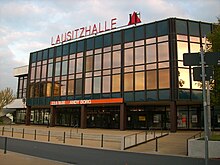Lausitzhalle Hoyerswerda
The Lausitzhalle Hoyerswerda ( Upper Sorbian Łužiska Hala ; until 1992 House of Mining and Energy Workers (HBE) ) is a culture and conference center in the new town of Hoyerswerda . It was built as the factory culture center of the Schwarze Pump gas combine and has 828 seats.
Emergence
Already planned as a residential area in 1955, the development of the city center of the new town was started very hesitantly. It should include buildings of overriding importance and create a transition to the old town.
A central cultural site was discussed in Hoyerswerda as early as the 1960s. The Alfred-Scholz-Halle, which had existed since 1958, was located relatively far away in the old town and could no longer have met the cultural requirements of a city that, according to forecasts, would have 110,000 inhabitants around the turn of the millennium. The first architectural draft in 1971 actually provided for a cinema, a studio stage, bowling alleys and a library, among other things. A smaller version of an architects' collective around Jens Ebert, which received the GDR architecture prize in 1985 , was then implemented.
construction
The groundbreaking ceremony took place on September 16, 1976, and the foundation stone was laid on January 3, 1977 ( Wilhelm Pieck's 101st birthday ). In October 1977 the stage tower was built within 14 days. However, it was not until April 30, 1984 that the house could be opened for the first time. At this point, however, only the building of the hall was completely finished (component I). The work on component II (foyer, gastronomy, administration) continued until the opening ceremony on October 7, 1985 ( Republic Day ).
The building was also realized as a so-called black investment outside of the overall economic planning and accounting. This also results in the extremely long construction time.
history
After 1989, the number of in-house productions and the number of employees had to be drastically reduced. 125 colleagues worked in the HBE, in the Lausitzhalle there are still 12. As a result of the fall of the wall, the house of mining and energy workers became the Lausitzhalle Hoyerswerda GmbH on June 22, 1992 . Traditional events such as the Christmas fairy tale or the New Year's Eve concerts have been preserved, and some former folk art collectives still have their place in the house. New traditions such as the Easter market and the summer theater in the castle courtyard have developed. The calendar of events offers a mix that is tailored to a city that has lost almost half of its almost 70,000 inhabitants. From 2009 to 2010 the former administrative wing was converted into the city's music and adult education center.
The first bars of the Steigerlied can still be heard today as a pause gong . A wall mosaic on the outside, designed by Fritz Eisel , was dedicated to the mining and energy workers in the region and is a cultural monument .
The Lausitzhalle in literature
“Sunday was miners day. There was a noise under the window where our theater was to be built in 1970. . . "
The writer Brigitte Reimann lived in Hoyerswerda from 1960 to 1968 and described the development with the words:
“Everything tastes like goodbye. [...] It's strange how you hung your heart on this barren landscape, on this impossible city, on the people [...]. Our Centrum department store looks elegant, but it is already run down a lot, sloppy like all the shops and restaurants here, which, according to who knows which devilish principle, become sluggish and lotterous, they barely exist for a few weeks. Still - if I think that there were only a few blocks in a sandy desert when we got here, and now it's a town of nearly 60,000, and the Combine has become a huge complex (with next to nothing working properly) The coal is running out, maybe in twenty years Hoy will be a ghost town like the abandoned gold digger settlements. Still (I'll say that again) we fought for a theater; that was my last prank here, and the people from the district will certainly remember me foully. After Siegfried had enforced it (after years of fighting), the theater building was canceled again. Cottbus wants to build a representative center, also at our expense. "
literature
- Herbert Richter: The house of the miners and energy workers. The Lausitzhalle Hoyerswerda . In: Neue Hoyerswerdaer Geschichtshefte 7, 2004, ZDB -ID 2015289-9 , pp. 24–31.
Web links
Coordinates: 51 ° 26 ′ 15.4 " N , 14 ° 15 ′ 46.2" E



